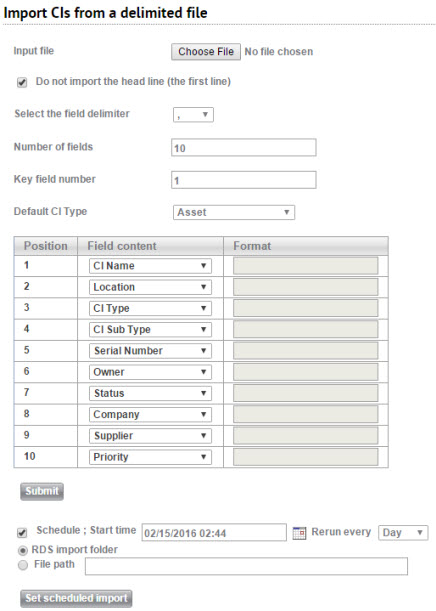This page allows you to easily import a list of CIs from a CSV file. You can also update existing CIs by reimporting them with updated information.

Importing a list of CIs
Please note:
The imported file cannot contain more than 1100 items.
To import a list of CIs:
Create a CSV file with the CIs you would like to import. You can easily create a CSV file using Microsoft Excel (save as CSV). Columns in the CSV are fields to import for each CI, and rows in the CSV are the individual CIs.

The columns include:CI name
Location
CI Type
Serial Number
Status
Navigate to Settings > CMDB > Import CIs from a delimited file.
Click Choose file and upload the file from your computer.
If your CSV has column headers (like in the picture above) select the Do not import the head line check box.
Select the field delimiter. If you create the CSV file in Excel, a comma (,) is used by default.
In the Number of fields field in SysAid, enter the number of fields to import. The number of fields is equal to the number of columns in your CSV file.
Choose a column as the key field for the import. The importance of the key field is to check if the CIs already exist in your system. If a CI already exists, SysAid updates it rather than creating a new one. Please make sure to use a field with unique values as the key. If you use a field with values that frequently appear, you will simply overwrite one of your CIs multiple times.
Choose the Default CI Type. Any new CI you import that doesn't have a specified type is created with the type you specify here.
Select each field you are importing in the Field content column. Each field corresponds to one column in the CSV file. The Field content in Position 1 is the left-most column in your CSV.
If you select any date fields, specify the date format in the Format column. You can use either European (dd/mm/yyyy) or US date formats (mm/dd/yyyy).
Click Submit to import your CIs.
You can verify that your CIs were correctly imported and/or updated from Assets > CMDB > CI List.
Importing Relational and Multi-Select Relational fields
You can import relational and multi-select relational list fields into the CI entity when using a CSV import.
The supported values for relational fields are:
Asset: asset ID (not the asset name)
Company: company name
User: user ID (not the user name)
Group: group name
Software Product: product ID (not the product name)
CI: CI ID (not the CI name)
For multi-select relational fields, multiple values must be separated by three @ signs (@@@). This matches the format you see below:

Automatically sync SysAid with a CSV file
You can set SysAid to automatically sync its CI information with a CSV file. This means that at the intervals you define, SysAid checks the CSV file for changes. If any changes have been made, SysAid imports the file and overrides the existing CI information with the updated information in the CSV file.
On-Premise users can accomplish this by pointing to the file location of the CSV file or by connecting to the CSV file via the RDS. Cloud users can perform this sync only by connecting to the CSV file via the RDS. The RDS scans the folder and uploads a copy of the CSV file to the server every 10 minutes. The server processes the updated information based on the selected schedule time.
To automatically sync your CIs with a CSV file via the SysAid server
Check the Schedule box.
In the Start Time field, select a date and time to begin syncing with the file.
From the Rerun Every drop-down list, select if the sync should occur every hour, day, or week.
Select the File path option button.
In the File Path field, enter the file path location of the CSV file.
Click Set scheduled import.
To automatically sync your CIs with a CSV file via the RDS
Check the Schedule box.
In the Start Time field, select a date and time to begin syncing with the file.
From the Rerun Every drop-down list, select if the sync should occur every hour, day, or week.
Select the File path option button.
Click Set scheduled import.
On your system, add a copy of the CSV file to the RDS folder under WEB-INF/csvCiFiles.
Please note:
Do not attempt to permanently store the original CSV file in this location as the RDS uploads it to the server and removes it from this location.
Access the RDS and open the DiscoveryService.properties file.
Find the "csv.ci.import" parameter and set its value to "true". If the parameter does not exist in the file, add it manually.
Save the file.
Restart the RDS service.
